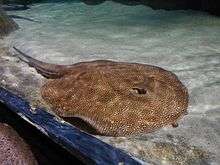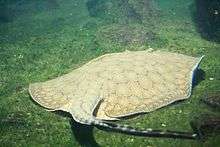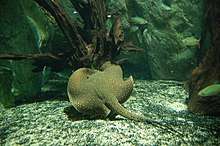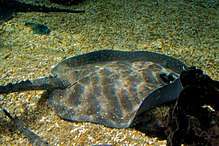Potamotrygon falkneri
Potamotrygon falkneri, the largespot river stingray or reticulated freshwater stingray, is a species of freshwater stingray in the family Potamotrygonidae from tropical and subtropical South America.[1][2] It is sometimes seen in the aquarium trade, but requires a very large tank.[3]
| Potamotrygon falkneri | |
|---|---|
 | |
| Scientific classification | |
| Kingdom: | |
| Phylum: | |
| Class: | |
| Subclass: | |
| Order: | |
| Family: | |
| Genus: | |
| Species: | P. falkneri |
| Binomial name | |
| Potamotrygon falkneri Castex & Maciel, 1963 | |
| Synonyms | |
| |
Taxonomy and appearance



This species was originally described by ichthyologists Castex and Maciel in 1963.[2]
This species is densely spotted above, but the exact color and pattern are very variable. One of these types was initially described as a separate species P. castexi and another as P. menchacai. Intermediates between the various patterns are common, and all represent variants of the species P. falkneri.[4] It reaches a disc width of up to 52 cm (20 in) and a total length, including tail, up to 89 cm (35 in).[4]
The so-called "tiger stingray" has sometimes been misidentified as P. menchacai (a synonym of P. falkneri), but it is a separate species that only was scientifically described as P. tigrina in 2011.[5]
Etymology
The etymology of the term Potamotrygon derives from the Greek words potamos, which means 'river', and trygon which means 'sting ray'.[2]
Distribution
This species has a disjunct distribution with the best-known population found throughout much of the Paraná—Paraguay River basin in southern Brazil, Paraguay, Uruguay and northeastern Argentina.[4] Initially it did not occur in the upper Paraná basin above the Guaíra Falls, but these disappeared after the construction of the Itaipu Dam, allowing this species (and several others) to spread.[6]
The other main distribution of P. falkneri is in the upper Amazon Basin: Madre de Díos, Guaporé, Beni, Marañón and Solimões Rivers in Bolivia, eastern Peru and western Brazil.[4]
References
- Góes de Araújo, M.L. (2009). "Potamotrygon falkneri". IUCN Red List of Threatened Species. 2009: e.T161353A5404947. doi:10.2305/IUCN.UK.2009-2.RLTS.T161353A5404947.en. Retrieved 15 January 2018.
- Froese, Rainer and Pauly, Daniel, eds. (2017). "Potamotrygon falkneri" in FishBase. February 2017 version.
- "Potamotrygon falkneri". SeriouslyFish. Retrieved 20 February 2017.
- da Silva, J.P.C.B; de Carvalho, M.R. (2011). "A taxonomic and morphological redescription of Potamotrygon falkneri Castex & Maciel, 1963 (Chondrichthyes: Myliobatiformes: Potamotrygonidae)". Neotrop. Ichthyol. 9 (1). doi:10.1590/S1679-62252011000100021.
- Carvalho, M.R.d., Sabaj Pérez, M.H. & Lovejoy, N.R. (2011). Potamotrygon tigrina, a new species of freshwater stingray from the upper Amazon basin, closely related to Potamotrygon schroederi Fernandez-Yépez, 1958 (Chondrichthyes: Potamotrygonidae). Zootaxa 2827: 1–30.
- Júlio Júnior, Dei Tós, Agostinho, and Pavanelli (2009). A massive invasion of fish species after eliminating a natural barrier in the upper rio Paraná basin. Neotropical Ichthyology 7(4): 709–18. doi:10.1590/S1679-62252009000400021
- Pedroso, Cátia M.; Jared, Carlos; Charvet-Almeida, Patricia; Almeida, Maurício P.; Neto, Domingos Garrone; Lira, Marcela S.; Haddad, Vidal; Barbaro, Katia C.; Antoniazzi, Marta M. (2007). "Morphological characterization of the venom secretory epidermal cells in the stinger of marine and freshwater stingrays". Toxicon. 50 (5): 688–97. doi:10.1016/j.toxicon.2007.06.004. PMID 17659760.
External links
![]()
